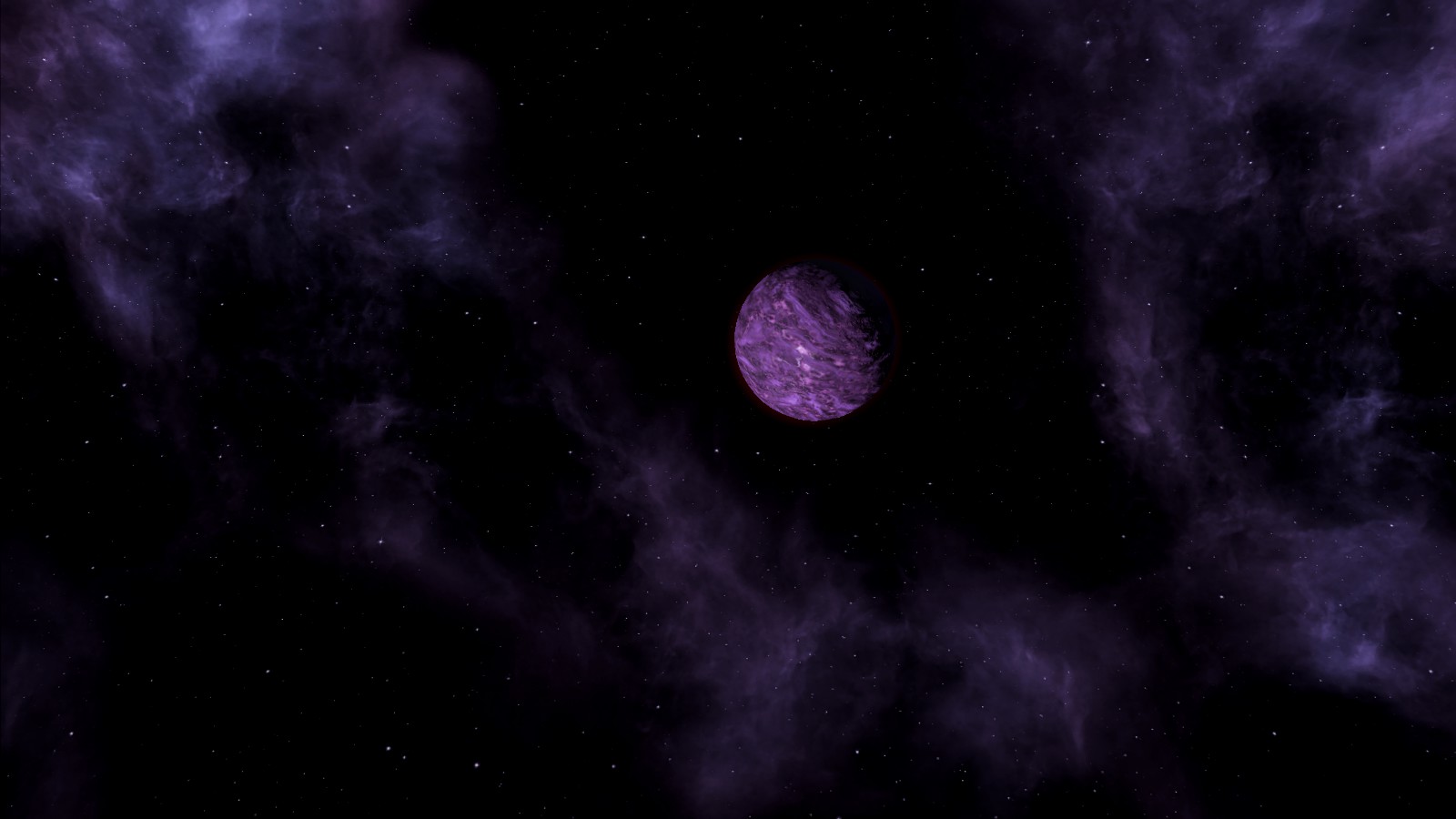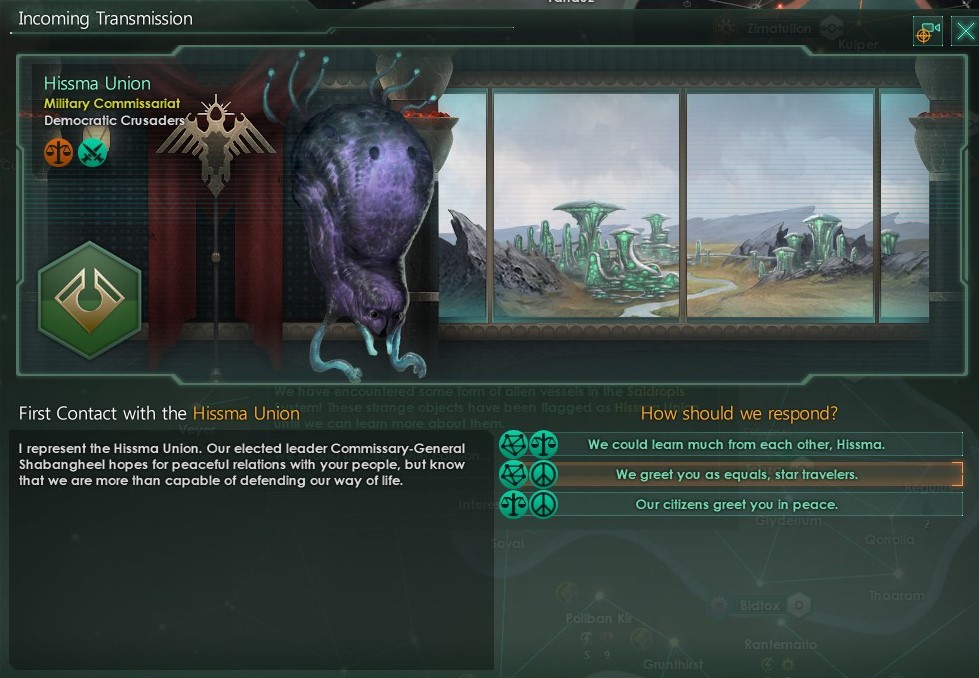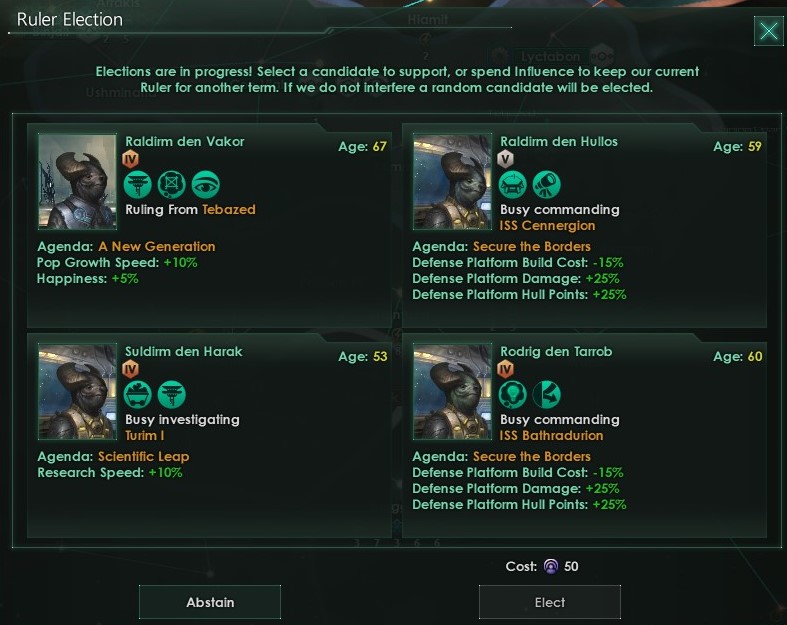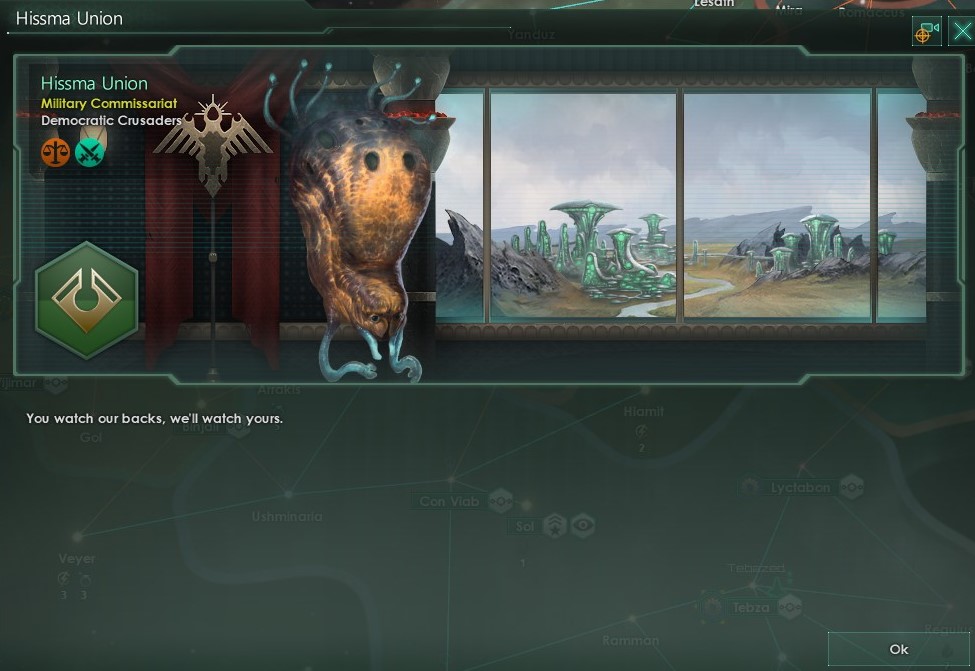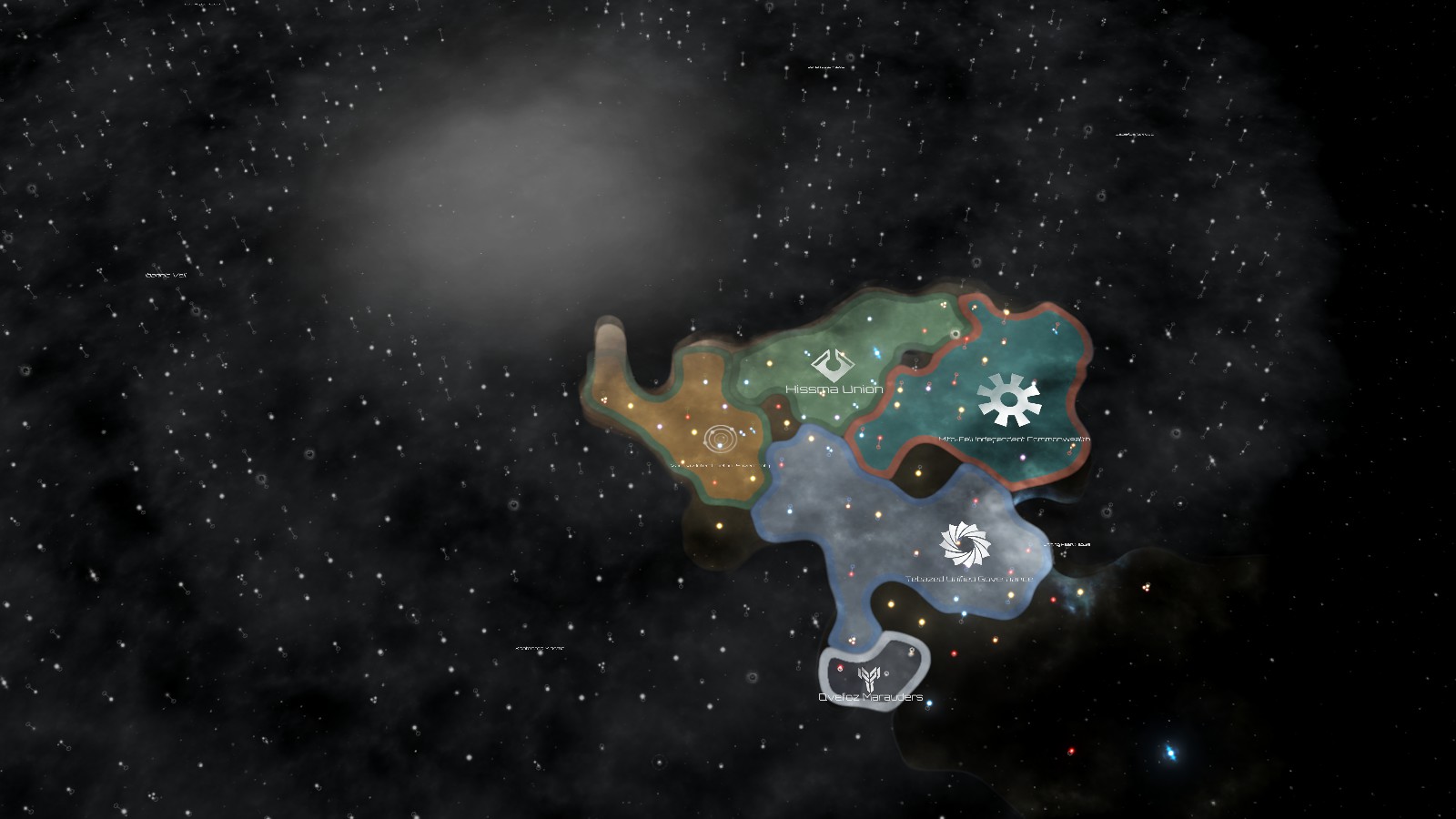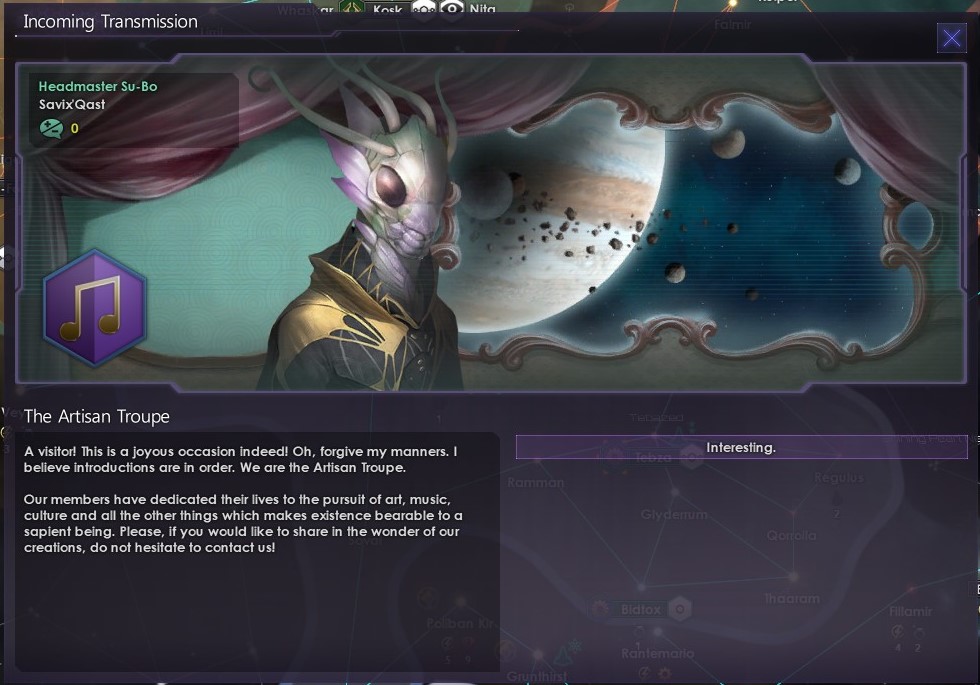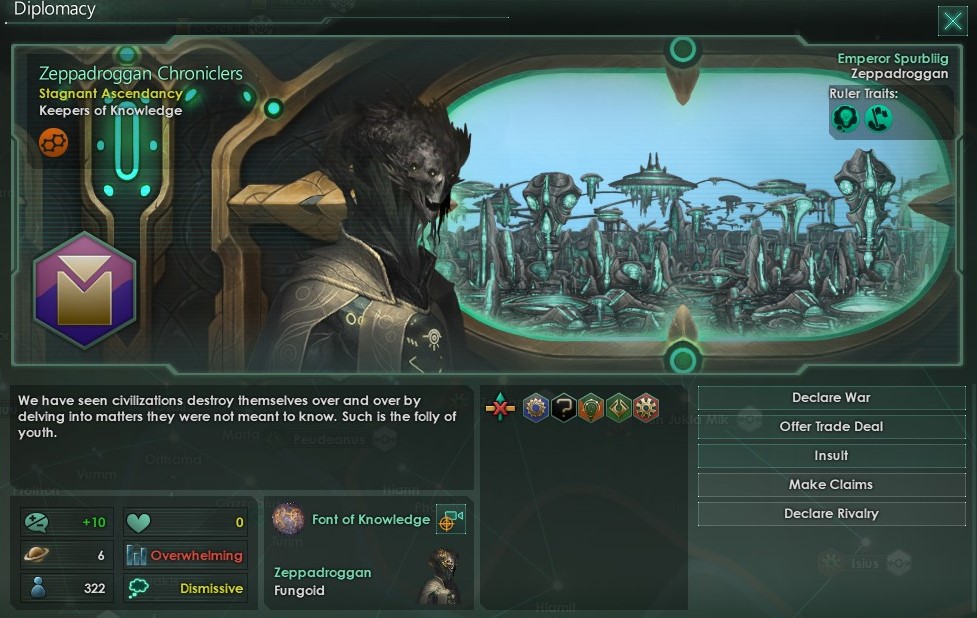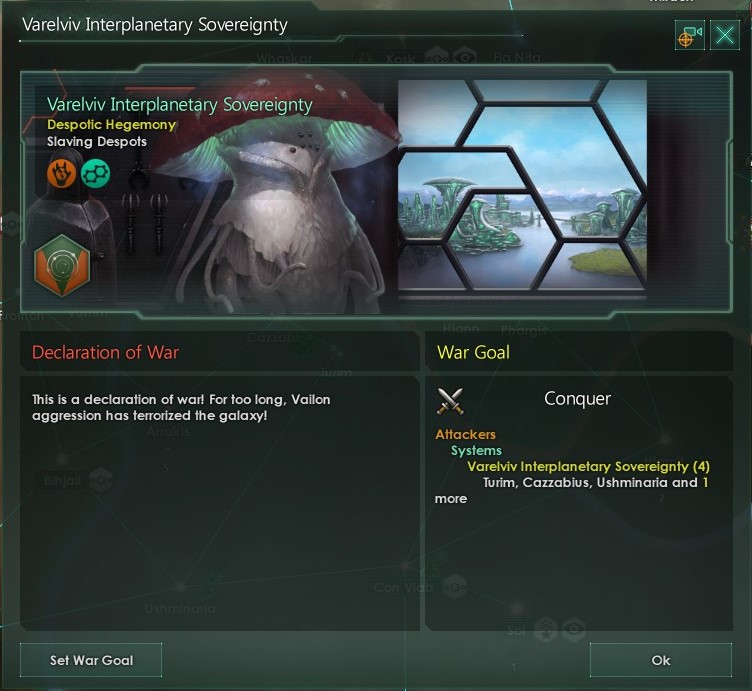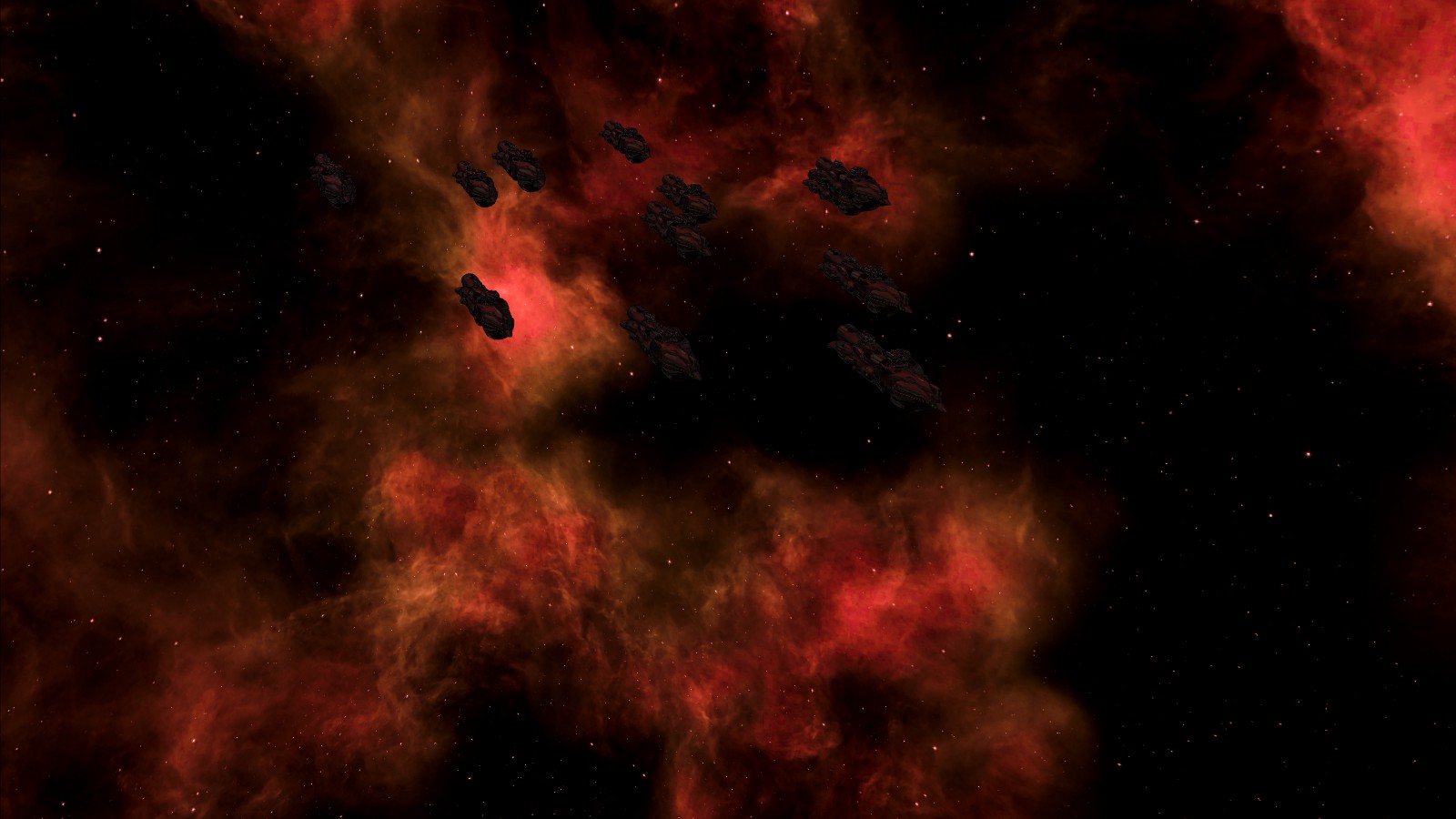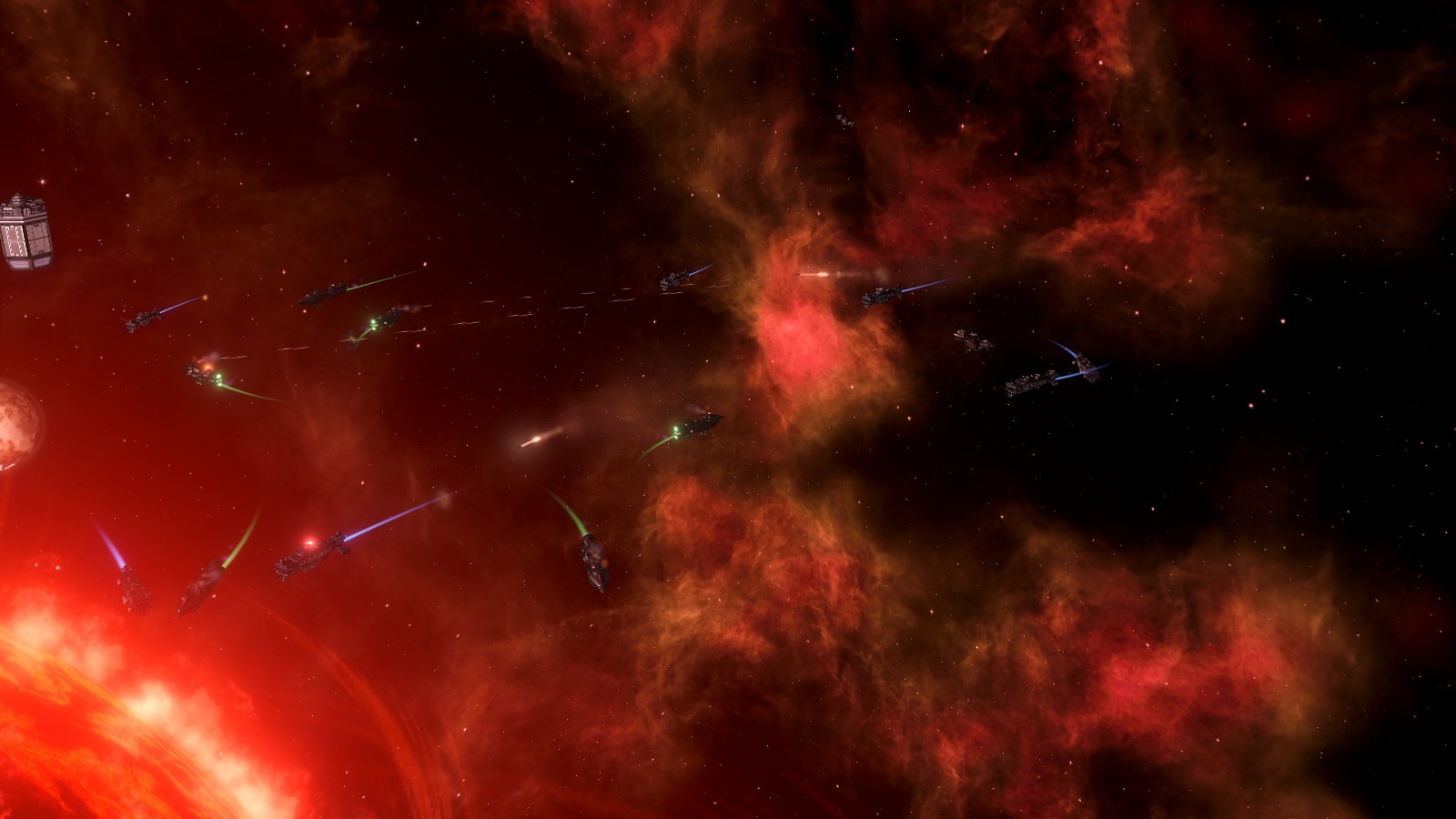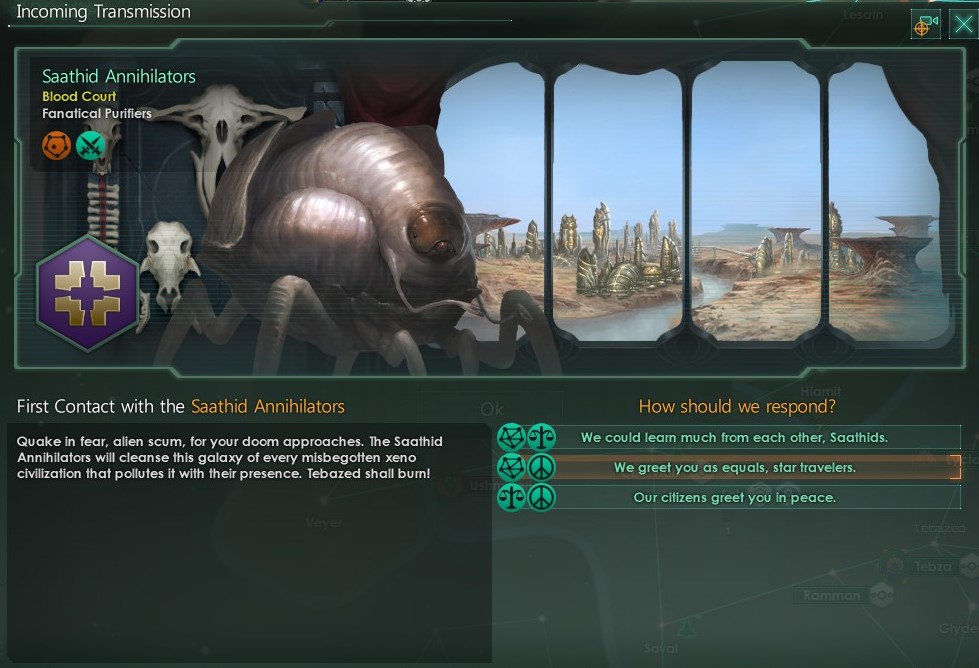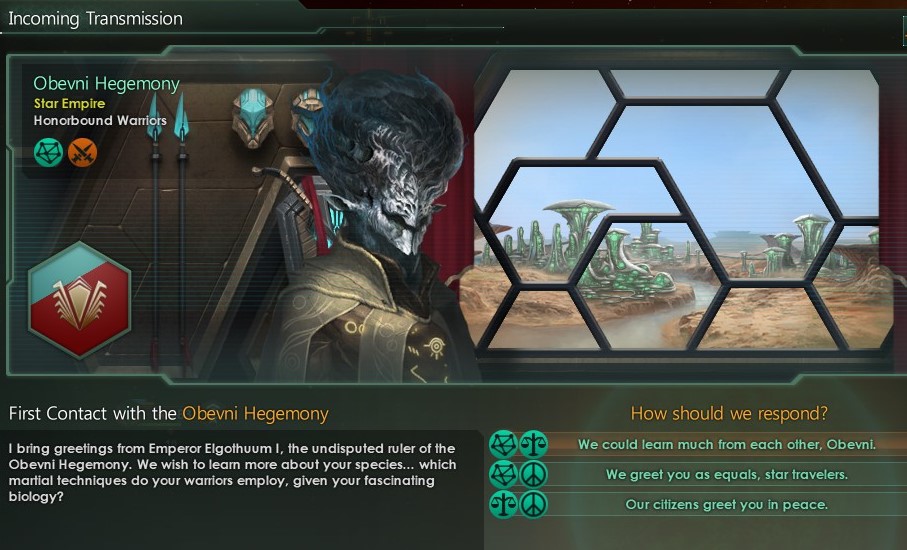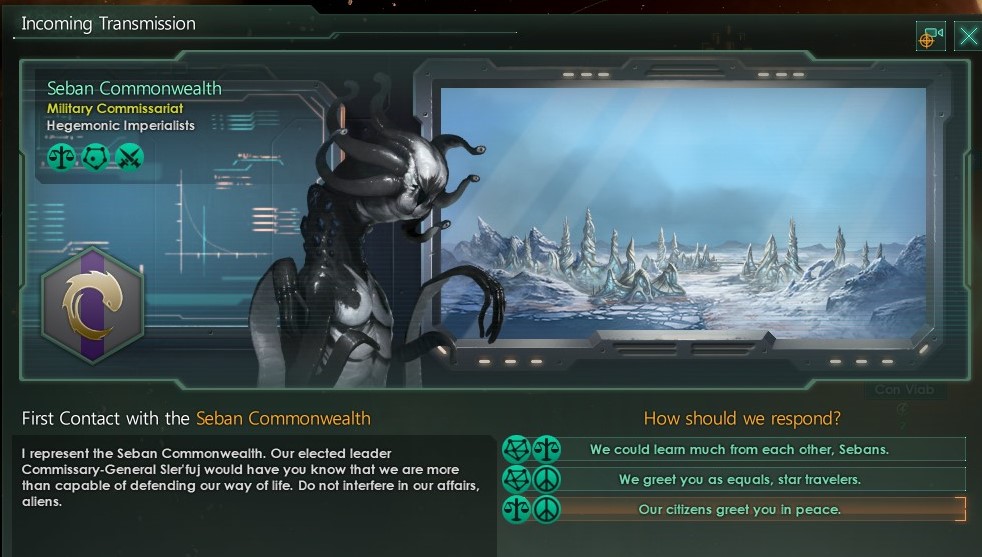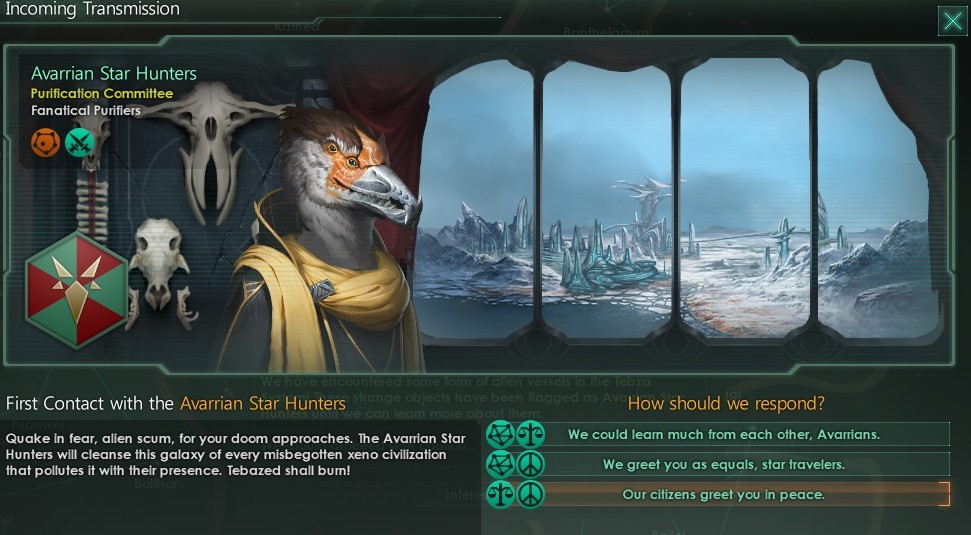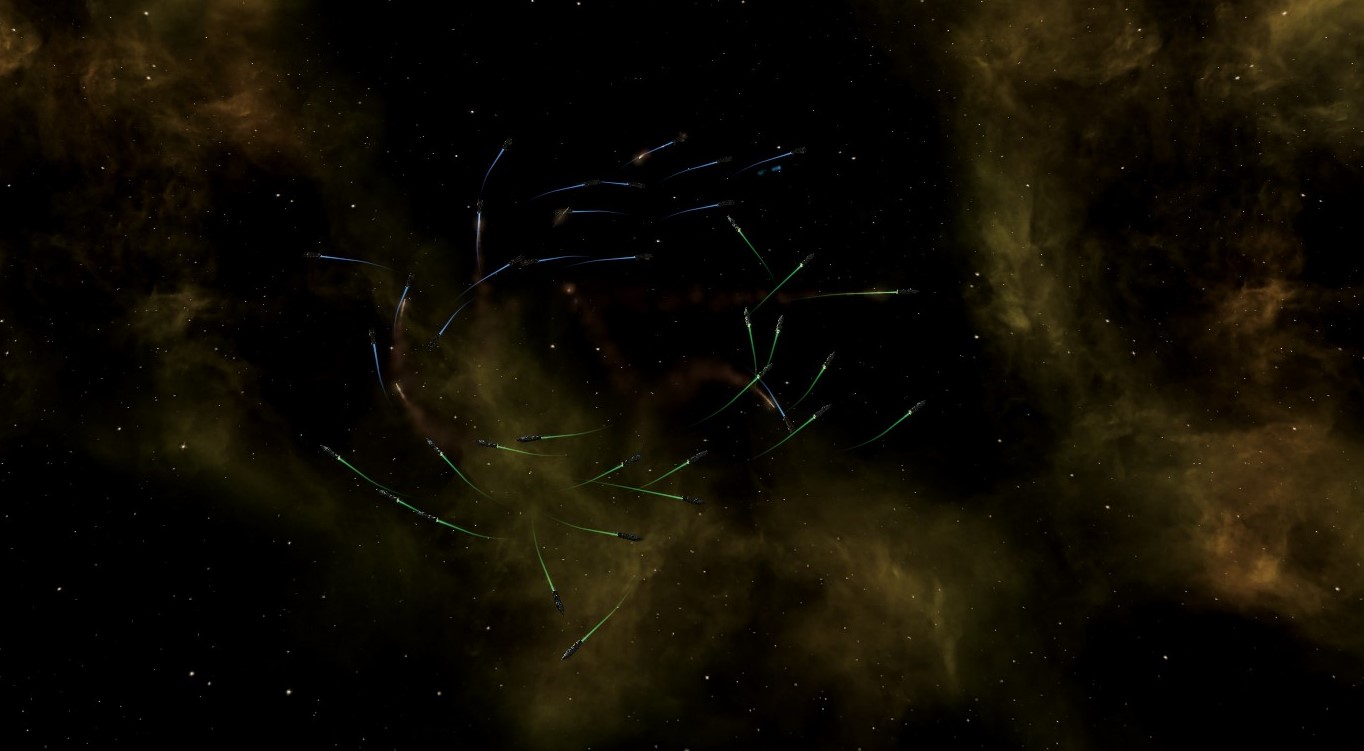Chapter Three - Scary Monsters
Chapter Three – Scary Monsters
Sometimes, the universe comes knocking to remind even the most brilliant minds that there is no narrative arc. Randomness is not only endemic, it is the dominant force in determining the course of events. In September of 211 Suldirm den Harak and the crew of the Dargion concluded their research into the mysterious ceramic object around Ramman. The end result of two years spent orbiting the star was… nothing. No explanation for its presence suggested itself from the thousands of scans taken with numerous different instruments and filters. The jar was completely unremarkable in every perceivable way. After running every test, the crew could think of, Harak finally surrendered to the absurdity. His penultimate report was a final detailing of their utter lack of any progress over 24 months and asking for permission to move on to other projects. The Science Directory, though loathe to give up after having invested so much time and energy, gave its approval, which prompted one final message from the crew, consisting of a single image of the jar with the caption, “This is not a jar.”
Despite the failure of this research – or, perhaps, thanks to the profound lessons learned – the TUG continued its rapid technological advancement. Tebazed society would have been virtually unrecognizable to someone living a mere two decades earlier. Vailons everywhere looked to the future with a sense of optimism and a belief in progress, their scientific achievements moving forward in time with their cultural achievements. But their faith was not blind; the outside world intruded on occasion. Starting in 212, the outside world began to intrude much more often. Over the next several years, many vailons would look back on their first decade as space explorers and frown at their past selves’ naiveté. Space was full of scary monsters, and sometimes those scary monsters attempted to bite.
In July, the Jhunustarion completed its survey of the Hiann system, on a spur of the hyperlane network. When they attempted to return to the main network, Hullos and the crew discovered that the Commonwealth had laid claim to the Phargis, at the other end of the only exit from Hiann. Over the next few days, delicate negotiations were conducted by the nascent diplomatic corps; the vailons wanted their ship to be given safe passage back to TUG-controlled space, but the mith-fell were concerned that the explorers would use the opportunity to gather intelligence on their activities. A compromise was reached: the crew of the Jhunustarion would be allowed to pass through Commonwealth space, on board their shuttles and escorted by a mith-fell ship, but the Jhunustarion itself would have to be left behind. [1] This did not sit well with the crew, who did not want their years of hard work and scientific research to fall into the hands of the clearly hostile avians. Hullos, awakened from her years-long depression by the circumstances, came up with a plan to create a reactor accident after they abandoned the ship, frying the computers and preventing the mith-fell from accessing any of their data. When the mith-fell returned to the explorer, several weeks later, they found an empty husk from which very little information could be gleaned. Though Hullos, upon her return to Tebazed, was hailed a hero, the Commonwealth leadership was incredibly displeased at having been deceived. Relations between the two states, if they could have ever been considered cordial, steadily worsened over the next year, culminating in a formal denunciation of the TUG in July of the following year.
In the aftermath of the incident, the first real political fight of the new age broke out amongst the factions in the Assembly. Hullos was celebrated by the people on Tebazed and praised in public by leadership in the Assembly and the administration. Privately, however, Director-General Vakor was furious. Diplomacy was difficult enough when faced with an adversary that could call on more direct power to back up its words; the last thing she needed was a rogue agent upsetting a painstakingly negotiated deal. Vakor was trying to build a better relationship with the Commonwealth, and Hullos had undermined years of work with her impulsive actions.
The leaders of the Peaceful Progress Initiative were similarly displeased. [2] They saw Hullos as a loose cannon whose ego overrode any feelings of obligations to the greater good. When she returned to the capital, they assumed that she would be debriefed and then unceremoniously fired for her insubordination and actions that threatened the peace and stability of the TUG. When no such decision was forthcoming, they reacted poorly. Ambushing the parliamentary leaders in the Assembly, their MAs spent an entire day of debate on the floor denouncing the out-of-control explorer and criticizing the Director-General for allowing such personnel to remain in her administration without incurring any consequences. The display may have sobered the public, as many began to consider the consequences of such a blatant provocation of their neighbors, but within the capital all the PPI earned was the enmity of their fellow politicians. Vakor’s allies in the Assembly, acting under the banner of the Liberty Now Council, pushed back against the attacks, calling them an unjustified assault on the prerogative of the Director-General. Vakor herself, politely maintaining her official distance from the fracas, was able to find an acceptable compromise, issuing a public reprimand to the pioneering explorer but also commissioning a new ship for Hullos to command as she continued the surveying mission of the Science Directory. The ISS Cennergion launched in October, and the Assembly moved on to other business; but relations were permanently soured between the two factions. [3]
Facing outright hostility from the Commonwealth, the vailons could only hope that other neighbors would prove more friendly. [4] When an alien outpost was identified in the Bihjall system in August of 214, excitement began to bubble to the surface again at the prospect of meeting new xenos. Unfortunately, first contact with the Varelviv Interplanetary Sovereignty [5] revealed them to be a polity fanatically devoted to hierarchical social institutions and a retrograde economic system. The representatives of Overlord Spagruum I laughed at the proposals of cooperation for mutual benefit presented by the vailon envoys; all they saw was a vast horde of new slaves to feed their growth, and they were not shy about saying so to the unarmed diplomatic mission. The VIS immediately closed their borders to all vailons, and within weeks had entirely cut off contact with the TUG. Such a pitiful state was not worth even speaking to.
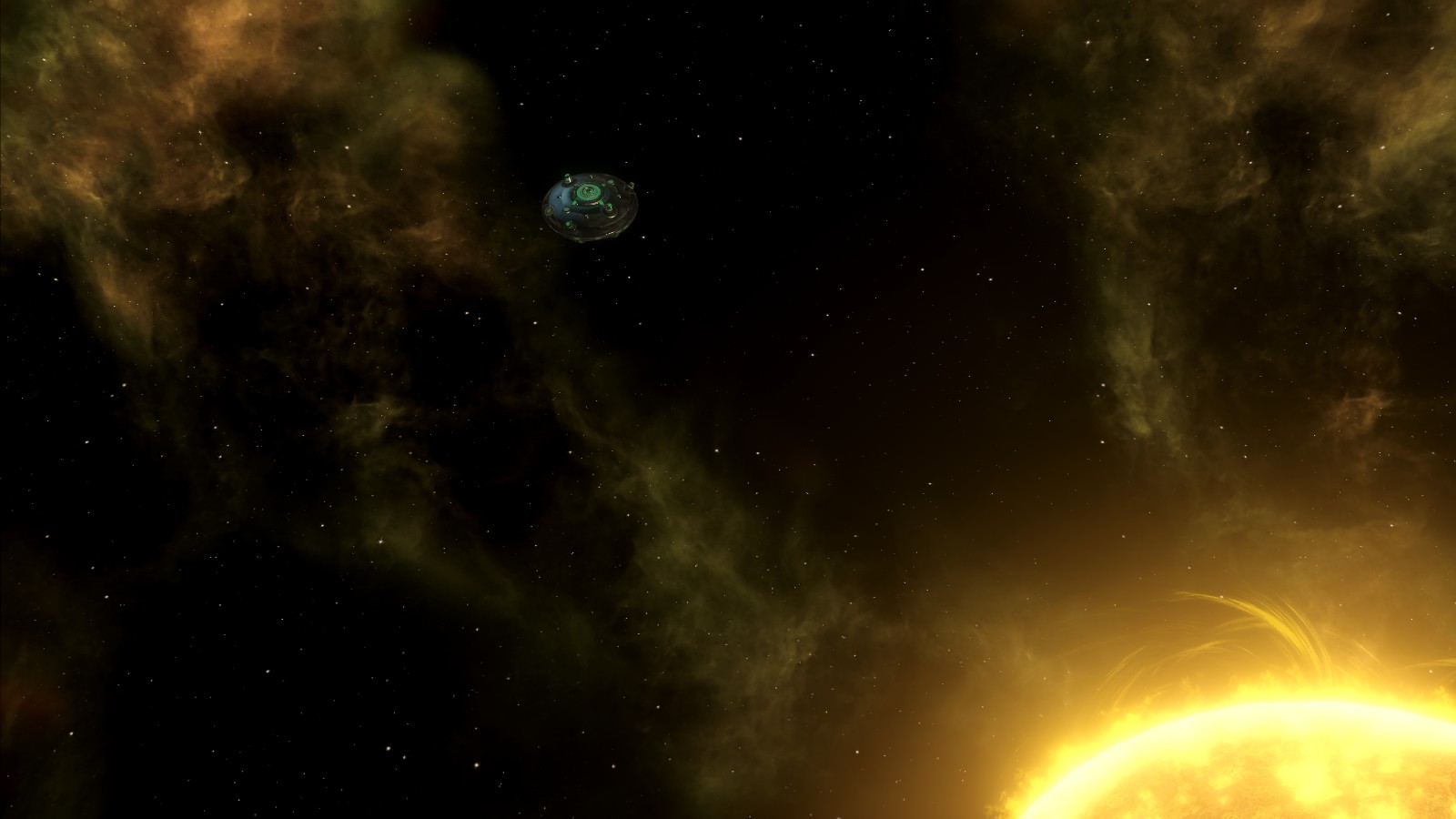
The VIS outpost encountered by the ISS Bathradurion in the Bihjall system.
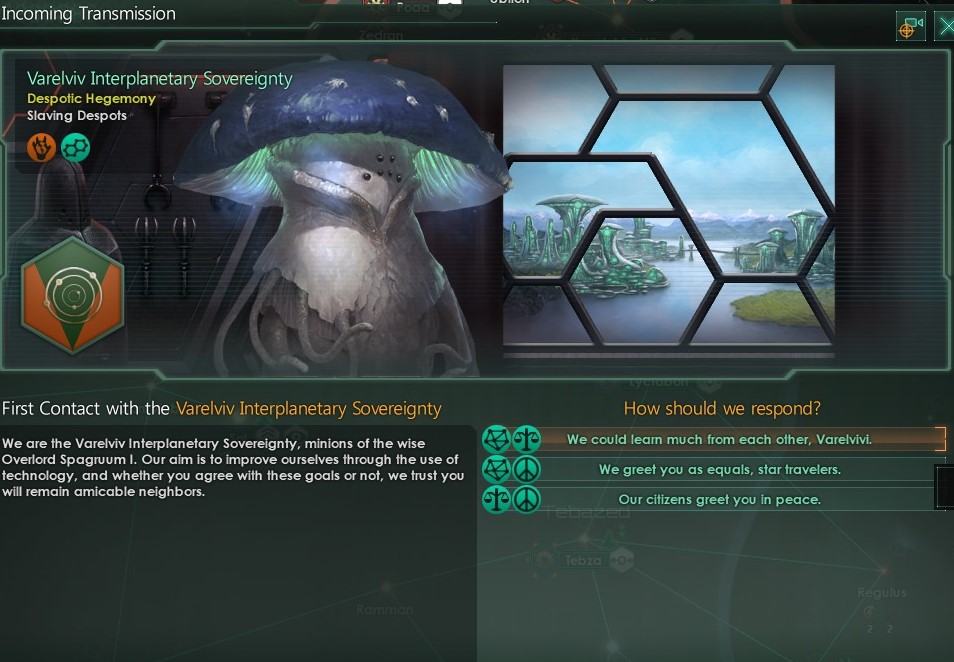
The varelviv slavers introduce themselves.
Concern boiled over into low levels of alarm in December, when an envoy was sent from Viverva with a message for Vakor and the administration. Overlord Spagruum I would be disposed to look kindly upon the vailons, the executive council was informed, if they would simply deign to ask for his protection. Surely they would welcome the security a strong state could provide, the envoy continued, especially when the TUG was surrounded by barbaric aggressors like the mith-fell. It went without saying that a dedicated tax would be leveed to compensate the VIS for their efforts. Anticipating the icy reception this proposal would receive, the envoy came armed with a sweetener: a guarantee that the varelviv would not move aggressively against any TUG holdings, and a firm commitment not to enslave any vailon citizens. There was never actually a question of the vailons agreeing to such an arrangement, however, and the envoy was informed within a few hours that the answer would be a firm no. If the VIS wanted their submission, they would have to force it upon them.
More difficult to decide were the choices that now lay in front of Vakor. The situation faced by the TUG was clear, the path forward much less so. They were an unmilitarized state, with virtually no ability to defend itself if confronted with force. A delicate balance would need to be struck. In this they had some advantages. The Commonwealth was, if anything, even more disposed to be hostile towards the VIS. A careful diplomatic approach could stave off aggressive actions by the rival powers; neither would want to see Tebazed in the orbit of, or outright annexed by, the other. The diplomatic corps would be promoted and expanded to meet the new needs of the state; significant resources would need to be applied to building out the infrastructure necessary to implement the new policy. But diplomacy was a vailon heritage, and many looked forward to the challenge with excitement.
Vakor, on the other hand, was painfully aware that the balancing act would work much better if the TUG could offer more than token resistance to an invasion. In the first decade and a half of space exploration, the administration had given no consideration to building a formal military organization. The Director-General believed it was time to change that. At the end of 215, the TUG “navy” stood at three ships strong. The patrol boats were outfitted with basic kinetic and laser guns and used primarily to deter low-grade piracy along the shipping routes between Tebazed and the colonies. Though Vakor could have simply begun the military expansion unilaterally, she felt that it would be important to engage with the Assembly and the vailon public on the question of the use of force. A long and difficult debate ensued, in which the PPI once again butted heads with the allies of the executive. Though the PPI acknowledged the need to deter the hostile neighbors, they felt that the best approach would be through economic expansion; if they came to rely on trade with the vailon, neither the mith-fell nor the varelviv would dare interfere with an important source of income. In a long speech on December 25, Vakor acknowledged that the PPI’s suggestion was a good one; however, she informed the Assembly that the current circumstances must be considered a crisis, and as a consequence some emergency measures would be necessary. The speech, which also outlined the exact threats faced by the vailon, focused the minds of the MAs, who concluded the debate shortly thereafter with a symbolic vote approving of Vakor’s plan. Within the week, construction commenced on expanded defensive infrastructure to control the key hyperlane juncture of Con Viab. Early in the new year, the three patrol boats were retrofitted with state-of-the-art coilguns, and a new corvette design was announced: a dedicated gunboat built around a single large nuclear missile launcher. Together these ships would form the nucleus of the newly formed Unified Navy. The vailons faced an uncertain future, but they were preparing to meet it head-on.
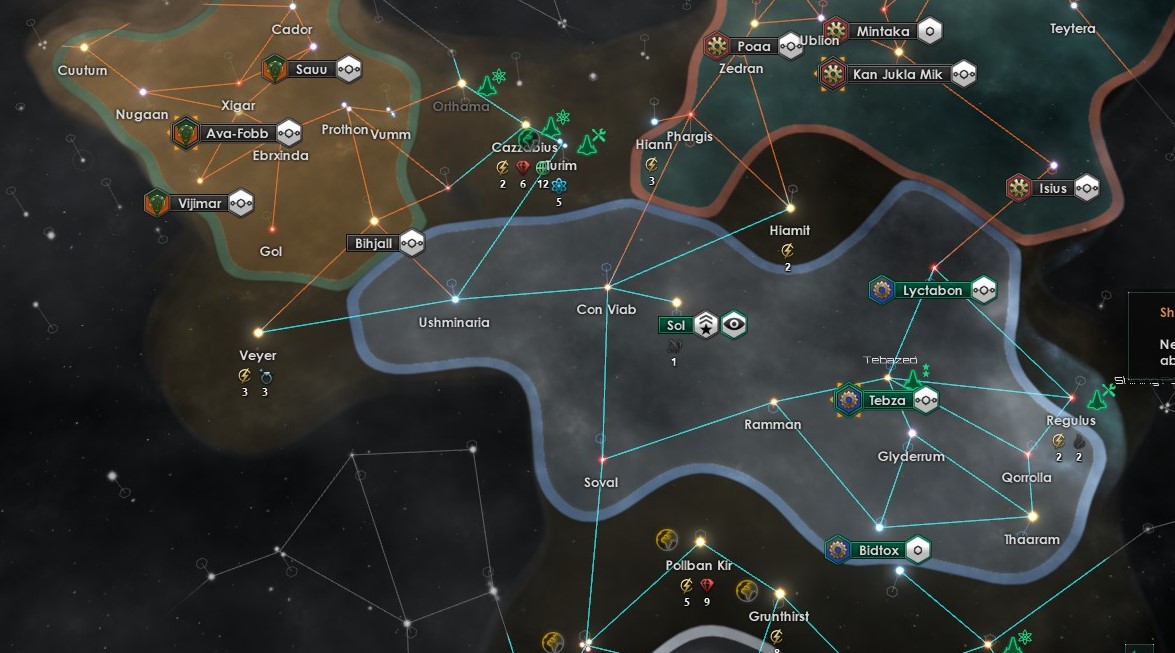
The TUG attempts to forge a course between hostile strangers.
Footnotes
Sometimes, the universe comes knocking to remind even the most brilliant minds that there is no narrative arc. Randomness is not only endemic, it is the dominant force in determining the course of events. In September of 211 Suldirm den Harak and the crew of the Dargion concluded their research into the mysterious ceramic object around Ramman. The end result of two years spent orbiting the star was… nothing. No explanation for its presence suggested itself from the thousands of scans taken with numerous different instruments and filters. The jar was completely unremarkable in every perceivable way. After running every test, the crew could think of, Harak finally surrendered to the absurdity. His penultimate report was a final detailing of their utter lack of any progress over 24 months and asking for permission to move on to other projects. The Science Directory, though loathe to give up after having invested so much time and energy, gave its approval, which prompted one final message from the crew, consisting of a single image of the jar with the caption, “This is not a jar.”
Despite the failure of this research – or, perhaps, thanks to the profound lessons learned – the TUG continued its rapid technological advancement. Tebazed society would have been virtually unrecognizable to someone living a mere two decades earlier. Vailons everywhere looked to the future with a sense of optimism and a belief in progress, their scientific achievements moving forward in time with their cultural achievements. But their faith was not blind; the outside world intruded on occasion. Starting in 212, the outside world began to intrude much more often. Over the next several years, many vailons would look back on their first decade as space explorers and frown at their past selves’ naiveté. Space was full of scary monsters, and sometimes those scary monsters attempted to bite.
In July, the Jhunustarion completed its survey of the Hiann system, on a spur of the hyperlane network. When they attempted to return to the main network, Hullos and the crew discovered that the Commonwealth had laid claim to the Phargis, at the other end of the only exit from Hiann. Over the next few days, delicate negotiations were conducted by the nascent diplomatic corps; the vailons wanted their ship to be given safe passage back to TUG-controlled space, but the mith-fell were concerned that the explorers would use the opportunity to gather intelligence on their activities. A compromise was reached: the crew of the Jhunustarion would be allowed to pass through Commonwealth space, on board their shuttles and escorted by a mith-fell ship, but the Jhunustarion itself would have to be left behind. [1] This did not sit well with the crew, who did not want their years of hard work and scientific research to fall into the hands of the clearly hostile avians. Hullos, awakened from her years-long depression by the circumstances, came up with a plan to create a reactor accident after they abandoned the ship, frying the computers and preventing the mith-fell from accessing any of their data. When the mith-fell returned to the explorer, several weeks later, they found an empty husk from which very little information could be gleaned. Though Hullos, upon her return to Tebazed, was hailed a hero, the Commonwealth leadership was incredibly displeased at having been deceived. Relations between the two states, if they could have ever been considered cordial, steadily worsened over the next year, culminating in a formal denunciation of the TUG in July of the following year.
In the aftermath of the incident, the first real political fight of the new age broke out amongst the factions in the Assembly. Hullos was celebrated by the people on Tebazed and praised in public by leadership in the Assembly and the administration. Privately, however, Director-General Vakor was furious. Diplomacy was difficult enough when faced with an adversary that could call on more direct power to back up its words; the last thing she needed was a rogue agent upsetting a painstakingly negotiated deal. Vakor was trying to build a better relationship with the Commonwealth, and Hullos had undermined years of work with her impulsive actions.
The leaders of the Peaceful Progress Initiative were similarly displeased. [2] They saw Hullos as a loose cannon whose ego overrode any feelings of obligations to the greater good. When she returned to the capital, they assumed that she would be debriefed and then unceremoniously fired for her insubordination and actions that threatened the peace and stability of the TUG. When no such decision was forthcoming, they reacted poorly. Ambushing the parliamentary leaders in the Assembly, their MAs spent an entire day of debate on the floor denouncing the out-of-control explorer and criticizing the Director-General for allowing such personnel to remain in her administration without incurring any consequences. The display may have sobered the public, as many began to consider the consequences of such a blatant provocation of their neighbors, but within the capital all the PPI earned was the enmity of their fellow politicians. Vakor’s allies in the Assembly, acting under the banner of the Liberty Now Council, pushed back against the attacks, calling them an unjustified assault on the prerogative of the Director-General. Vakor herself, politely maintaining her official distance from the fracas, was able to find an acceptable compromise, issuing a public reprimand to the pioneering explorer but also commissioning a new ship for Hullos to command as she continued the surveying mission of the Science Directory. The ISS Cennergion launched in October, and the Assembly moved on to other business; but relations were permanently soured between the two factions. [3]
The delegate from Muntadar would besmirch the intuition of the great pioneer of the vailon space program. Her actions in this case were ingenious and prevented our research from falling into the hands of those who would use it against us. I ask the delegate from Muntadar what would she have done in the same circumstances? I would not have had the courage to act, and I think the same is true of most members of this august body…
-Kunrig den Armok, during debate in the Assembly, August 3, 212
Facing outright hostility from the Commonwealth, the vailons could only hope that other neighbors would prove more friendly. [4] When an alien outpost was identified in the Bihjall system in August of 214, excitement began to bubble to the surface again at the prospect of meeting new xenos. Unfortunately, first contact with the Varelviv Interplanetary Sovereignty [5] revealed them to be a polity fanatically devoted to hierarchical social institutions and a retrograde economic system. The representatives of Overlord Spagruum I laughed at the proposals of cooperation for mutual benefit presented by the vailon envoys; all they saw was a vast horde of new slaves to feed their growth, and they were not shy about saying so to the unarmed diplomatic mission. The VIS immediately closed their borders to all vailons, and within weeks had entirely cut off contact with the TUG. Such a pitiful state was not worth even speaking to.

The VIS outpost encountered by the ISS Bathradurion in the Bihjall system.

The varelviv slavers introduce themselves.
More difficult to decide were the choices that now lay in front of Vakor. The situation faced by the TUG was clear, the path forward much less so. They were an unmilitarized state, with virtually no ability to defend itself if confronted with force. A delicate balance would need to be struck. In this they had some advantages. The Commonwealth was, if anything, even more disposed to be hostile towards the VIS. A careful diplomatic approach could stave off aggressive actions by the rival powers; neither would want to see Tebazed in the orbit of, or outright annexed by, the other. The diplomatic corps would be promoted and expanded to meet the new needs of the state; significant resources would need to be applied to building out the infrastructure necessary to implement the new policy. But diplomacy was a vailon heritage, and many looked forward to the challenge with excitement.
Vakor, on the other hand, was painfully aware that the balancing act would work much better if the TUG could offer more than token resistance to an invasion. In the first decade and a half of space exploration, the administration had given no consideration to building a formal military organization. The Director-General believed it was time to change that. At the end of 215, the TUG “navy” stood at three ships strong. The patrol boats were outfitted with basic kinetic and laser guns and used primarily to deter low-grade piracy along the shipping routes between Tebazed and the colonies. Though Vakor could have simply begun the military expansion unilaterally, she felt that it would be important to engage with the Assembly and the vailon public on the question of the use of force. A long and difficult debate ensued, in which the PPI once again butted heads with the allies of the executive. Though the PPI acknowledged the need to deter the hostile neighbors, they felt that the best approach would be through economic expansion; if they came to rely on trade with the vailon, neither the mith-fell nor the varelviv would dare interfere with an important source of income. In a long speech on December 25, Vakor acknowledged that the PPI’s suggestion was a good one; however, she informed the Assembly that the current circumstances must be considered a crisis, and as a consequence some emergency measures would be necessary. The speech, which also outlined the exact threats faced by the vailon, focused the minds of the MAs, who concluded the debate shortly thereafter with a symbolic vote approving of Vakor’s plan. Within the week, construction commenced on expanded defensive infrastructure to control the key hyperlane juncture of Con Viab. Early in the new year, the three patrol boats were retrofitted with state-of-the-art coilguns, and a new corvette design was announced: a dedicated gunboat built around a single large nuclear missile launcher. Together these ships would form the nucleus of the newly formed Unified Navy. The vailons faced an uncertain future, but they were preparing to meet it head-on.

The TUG attempts to forge a course between hostile strangers.
Footnotes
[1] The mith-fell planned, of course, to take advantage of the situation by picking over the abandoned vailon explorer. It would be a major coup for their intelligence services.
[2] Though Suldirm den Harak nominally led the faction, his current posting on the Dargion prevented him from directing the organization. Instead, at the current time he served as a symbolic leader and a guiding light.
[3] The formal denunciation of the TUG by the Commonwealth a few months later, while treated very seriously by the administration and the diplomatic corps, did not make any waves in the Assembly or the public discourse. Though it constituted an official severing of relations, the act itself did not change any fundamental factors in the relationship between the two states.
[4] Vailon xenobiologists were now very confident that the galaxy was full of sapient, spacefaring species, given the evident density of life generally and intelligent life specifically in their immediate star cluster.
[5] A translation of Va was completed by the Sociology Section in April, 215.
[2] Though Suldirm den Harak nominally led the faction, his current posting on the Dargion prevented him from directing the organization. Instead, at the current time he served as a symbolic leader and a guiding light.
[3] The formal denunciation of the TUG by the Commonwealth a few months later, while treated very seriously by the administration and the diplomatic corps, did not make any waves in the Assembly or the public discourse. Though it constituted an official severing of relations, the act itself did not change any fundamental factors in the relationship between the two states.
[4] Vailon xenobiologists were now very confident that the galaxy was full of sapient, spacefaring species, given the evident density of life generally and intelligent life specifically in their immediate star cluster.
[5] A translation of Va was completed by the Sociology Section in April, 215.
Last edited:


